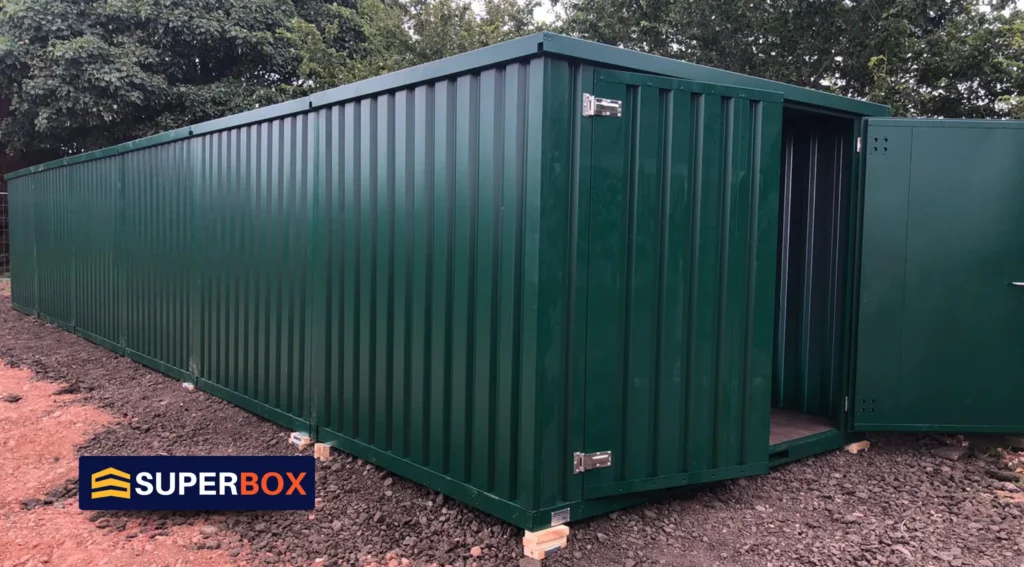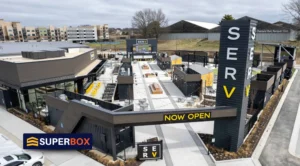Delivering a 40 ft shipping container involves several crucial steps that ensure safe delivery, proper placement, and long-term use of the container. Whether you’re using it for storage, construction, or shipping, it’s important to be prepared for the entire process, from clearing the site to understanding delivery truck options. Here’s a detailed guide, covering everything you need to know to ensure a smooth shipping container delivery process and proper container placement.

1. Preparing for Delivery: Site Preparation
Preparing your site before the delivery truck arrives is critical to ensuring that everything goes smoothly. Poor site preparation can lead to complications, delays, or even damage to the container or delivery equipment. Here’s what you need to do:
- Level Ground: The first step in preparing your site is making sure the ground is level and stable. A 40 ft container weighs several tons, so placing it on uneven or soft ground could cause it to sink or tilt, leading to problems with the structure and function of the container. Placing the container on a solid base, such as railroad ties, gravel, or concrete blocks, ensures that it remains stable over time.
- Space for Delivery: You’ll need enough space to accommodate the size of the delivery truck and the container. A 40 ft container requires a delivery truck with a long trailer, which typically needs around 100 feet of space to back in and unload. Ensure that the path to the drop-off point is clear of obstacles such as hanging tree branches, fences, or narrow gates. Please note that the delivery truck is much larger than a typical vehicle, so having clear, wide access is essential.
- Clear Access Path: Make sure that the truck can easily access your site. If your driveway is narrow or the delivery site is hard to reach, you might need to remove obstructions ahead of time. Be sure to communicate with the delivery company about any specific obstacles or limitations on your property to ensure a smooth delivery process.
2. Choosing the Right Delivery Option: Truck Types and Methods
The delivery method you choose will depend on the layout of your site and the level of precision required for placing the container.

- Tilt-Bed Truck Delivery: This is the most common delivery method for 40 ft containers. The tilt-bed truck, also known as a roll-off truck, arrives at your site, and the truck bed is raised at an angle to slide the container off. This method is simple and efficient, but it requires plenty of space for the truck to maneuver. It’s ideal for open areas with level ground, and it’s one of the most cost-effective ways to deliver a shipping container.

- Flatbed Truck Delivery: If your site has limited space, a flatbed truck may be a better option. With this method, the container is placed on the flatbed, and a delivery driver will use additional equipment, such as a forklift or crane, to unload it. This method is commonly used for urban or restricted spaces where a tilt-bed truck might not have enough room to operate. Keep in mind that the flatbed method may come with extra costs due to the need for special equipment.

- Crane Delivery: For even more difficult sites—such as those that require the container to be lifted over obstacles like walls or onto raised platforms—crane-assisted delivery is available. This method allows for very precise placement but is also the most expensive option due to the specialized equipment involved. Crane delivery is often used for construction projects or when the container needs to be placed in hard-to-reach areas.

3. Delivery Day: The Container Drop-Off Process
On the day of delivery, it’s important to be on-site to oversee the process. Being present allows you to guide the delivery driver and make sure the container is placed exactly where you want it.
- Site Inspection: Before unloading begins, the delivery team will inspect the site to make sure everything is prepared. They will check that the ground is level and stable and that there is enough room to unload the container safely. If any issues arise, such as obstacles that weren’t cleared or uneven ground, they might need to make adjustments.
- Unloading the Container: For a tilt-bed delivery, the truck bed is raised, and the container slowly slides off. You’ll need to make sure that the area is clear of any people or equipment that could get in the way of the unloading process. Once the container is on the ground, the driver will make any final adjustments to position it exactly as needed.
- Flatbed and Crane Unloading: With a flatbed or crane delivery, the process is more involved. A forklift or crane will lift the container off the truck and place it on the site. This method is typically used when there are tight spaces or when the container needs to be placed on elevated platforms or areas with limited access.
- Final Placement: After the container is placed, check that it’s sitting properly on the foundation and that it’s level. If the container is not level, the doors may become difficult to open and close, or the structure could be compromised over time.

4. Post-Delivery Considerations: Ensuring Proper Setup
Once the container is in place, there are a few final steps to ensure it’s ready for use and will remain in good condition for the long term.
- Foundation and Drainage: Make sure the container is placed on a solid foundation, such as railroad ties or concrete blocks. This prevents it from sinking or shifting over time. Additionally, it’s important to ensure that there is proper drainage around the container. If water pools around the base, it could cause rust and other damage. Elevating the container slightly off the ground helps with drainage and extends the lifespan of the container.
- Inspecting the Container: After the container is delivered, it’s important to inspect it for any damage that may have occurred during transport. Check for dents, rust, or other issues. Make sure the container is wind and watertight (WWT) if you’re using it for storage, as this will protect your goods from the elements.

5. Important Tips for a Successful Delivery
To ensure the entire process goes smoothly, here are some extra tips for preparing for your container delivery:
- Plan for Weather: Delivery day can be affected by weather conditions. Avoid scheduling delivery on rainy or snowy days, as wet or muddy ground can make it hard for the truck to access your site and could cause the container to sink into soft ground. Always check the weather forecast ahead of time and reschedule if necessary.
- Check Local Regulations: Before delivery, check with your local government about any zoning laws or permits you might need for placing a 40 ft shipping container on your property. Some municipalities have regulations about where and how you can use a container, especially for long-term storage or as a workspace.
- Clear Communication: Always communicate clearly with the delivery team, making sure they understand any special instructions or conditions at your site. If your delivery site has unique challenges, such as limited space or obstacles, let the team know in advance so they can prepare accordingly.
Conclusion
The delivery process for a 40 ft shipping container requires careful planning and preparation to ensure everything goes smoothly. From clearing the delivery site to choosing the right delivery option, understanding each step of the process can help you avoid common issues like sinking, misalignment, or accessibility problems. SuperBox is dedicated to making the container delivery process as easy and efficient as possible. For more information about our services or to schedule your container delivery, give us a call at 1-866-696-9269.
With the right preparation and support, you can successfully deliver and set up your 40 ft shipping container with ease!





